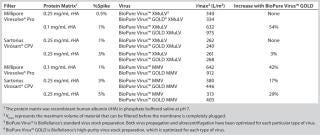Filterability of Virus StocksFilterability of Virus Stocks
August 1, 2012

Small-pore, virus-retentive nanofilters are designed to remove even tiny viruses from a biological product intermediate as it flows through the filter membrane. During process development, manufacturers carefully optimize filtration conditions to maximize product throughput so that at manufacturing scale, the number and size of these expensive virus filters can be minimized. During the viral clearance study, an attempt is made to filter a targeted volume based on preceding process development studies. If the filter’s pores become plugged with impurities from the virus spike, the total volume that can be filtered may be limited. Because the maximum filtration volume at manufacturing scale is based on throughput achieved during the viral clearance study, it is important to reduce any impurities in the virus prep that might plug the filter and potentially threaten filter capacity. This concern can be mitigated by the use of a high-purity virus stock.
BioReliance’s standard virus stocks, BioPure Virus™, have always gone through an ultracentrifugation-based purification step following harvest of the virus from infected cells and have been successfully used in many clearance studies for virus retentive filters. We have recently developed a second type of stock, BioPure Virus™ GOLD, which includes an additional level of purification. Because each virus is biochemically unique and has evolved its own biologically distinct method for infection of host cells, we have optimized propagation and purification procedures specific for each individual virus. Although each lot of BioPure Virus™ and BioPure Virus™ GOLD is characterized for residual protein, RNA, and DNA as well as adventitious agents, the definitive factor in determining whether a virus stock is suitable for use is its performance. Therefore, every lot of BioPure Virus™ GOLD is evaluated for its filterability in a virus-retentive filtration step.
A number of factors influence filter capacity, including the biochemical characteristics of the product molecule, pH and conductivity of the buffer, the filter itself, and the quality of the virus spike. Vmax represents the maximum volume of material that can be filtered before the membrane becomes completely plugged and is a good way to quantitatively compare filtrations. As the Vmax value increases, so does maximum volume that can be put through the filter. The data in Table 1 compare virus filter capacity (Vmax) using BioPure Virus™ and BioPure Virus™ GOLD spikes and demonstrate that although some filters are less sensitive to virus stock purity and the impact on filter capacity is minimal, in other cases the use of the BioPure Virus™ GOLD stock markedly increases the capacity of the filter. Use of a high-purity stock also facilitates increasing the amount of virus that can be used as a spike. Spikes of ≤3% (XMuLV) or 5% (MMV) were used, increasing the potential virus reduction for the step.
Table 1: Filter capacity when process intermediate is spiked with BioPure Virus™ compared with BioPure Virus™ GOLD virus

Table 1: Filter capacity when process intermediate is spiked with BioPure Virus™ compared with BioPure Virus™ GOLD virus ()
Under some filtration conditions, use of a purified virus stock can increase the throughput of a virus-spiked filter load. In addition, purified virus can be spiked to a higher concentration, increasing the potential log reduction. BioPure Virus™ GOLD stocks of XMuLV, MMV and Reo3 are now available for use in virus reduction filtrations or other studies where a high-purity virus spike may be required.
About the Author
Author Details
Kathryn Martin Remington, MS, PhD, is principal scientist in clearance services at BioReliance Corporation, 14920 Broschart Road, Rockville, MD 20850; 1-240-447-6280. Virosart® is a registered trademark of Sartorius Stedim Biotech GmbH. Viresolve® Pro is a registered trademark of Millipore Corporation.
You May Also Like






